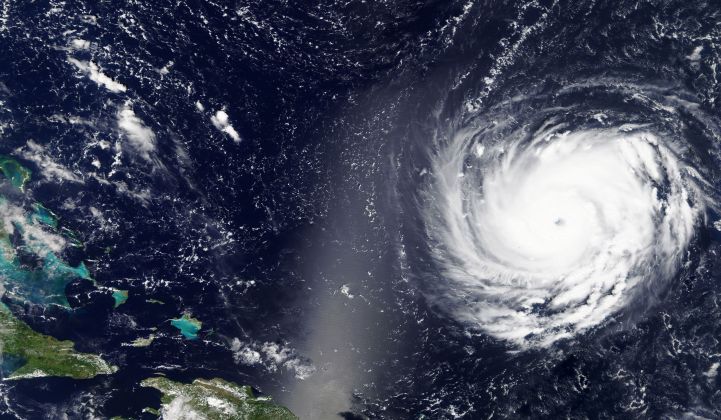Around the time that Hurricane Florence was battering North Carolina with record rainfall last year, scientists published research indicating climate change widened the storm’s diameter and increased rainfall by 50 percent in some areas.
More broadly, climate change means storms and hurricanes bring more rain, higher intensity and likely a slower pace — plopping down and wreaking havoc on impacted areas for longer spans of time, researchers say. This means a greater threat to human life and more extensive damage to critical infrastructure such as water, sewer and power grids — or, increasingly, solar panels.
Though most North Carolina solar operators said their panels went unharmed during Florence, quality experts say assessing only visible damage may prove insufficient as storms increase.
Catching up with a solar fleet operator post-storm, PV Evolution Labs CEO Jenya Meydbray identified a few holes in the usual process of cataloging damage and processing insurance claims.
“If a module was shattered, obviously that was cataloged; if a rack collapsed, that was cataloged; if an inverter was flooded, that was put in the bucket for the insurance claim,” he said. “I asked about the modules adjacent to the modules that were shattered, and they said, ‘Nothing, those are still there.’”
That leaves a system vulnerable, according to Meydbray.
“The reality of the situation is, those will likely result in an underperforming site in some amount of time,” he said.
A new partnership
To prevent underperformance associated with invisible and miniscule panel cracks, PV Evolution Labs has just launched a new partnership with aerial inspection company Heliolytics. The two companies will join forces, with Heliolytics performing aerial inspections of solar sites, and PVEL then putting boots on the ground for more granular performance tests.
The two companies have already partnered on several projects and said they’ve observed “widespread microcracking” on installations where glass visibly broke on less than 5 percent of modules.
“There needs to be a way to assess cell cracks in the field without uninstalling the modules,” said Meydbray. “That's the nature of the partnership: It’s the most efficient and cost-effective way to address post-incident assessment of module damage.”
Most solar owners sign up with Heliolytics for baseline testing as part of a site’s operation and maintenance. The company surveys sites using aircraft-based infrared and electro-optical sensors, which identify physical damage and hot spots that may indicate panel problems invisible to the naked eye.
With the new service, Heliolytics will also perform that analysis after catastrophic weather events like hurricanes, hail or tornadoes. After identifying potential points of failure, PVEL can then deploy technicians to a site to perform on-the-ground electroluminescence tests.
While that type of testing has been cost-prohibitive in the past, Meydbray says the PVEL team (which split from DNV GL early in 2019) has worked to bring down prices in recent years. Getting a better read on which panels are actually damaged should also reduce exposure for insurers, who won’t be tasked with replacing “everything or nothing — which happens today,” according to Meydbray.
The motivation for the new service comes in part from the growing threat that climate change presents to solar systems. As the resource expands into new territories and climate change worsens the impacts of natural disasters, Heliolytics CEO Rob Andrews said operators will have to prepare for damage.
“We've talked to a lot of clients who have seen the 100- and 500-year floods a few years in a row. So, we’re seeing the historical norms are not matching what we're seeing going forward,” said Andrews. “It means that some of the proactive measures that may have been appropriate in the past might not be appropriate now.”
At the same time, tightening solar margins have put pressure on operators to keep plants in tip-top shape at all times.
“People aren't making extra money in operating sites, [and] they have to keep them operating at full capacity in order to hit the numbers,” said Meydbray. “So there's just much more attention to more sophisticated maintenance than there used to be.”




